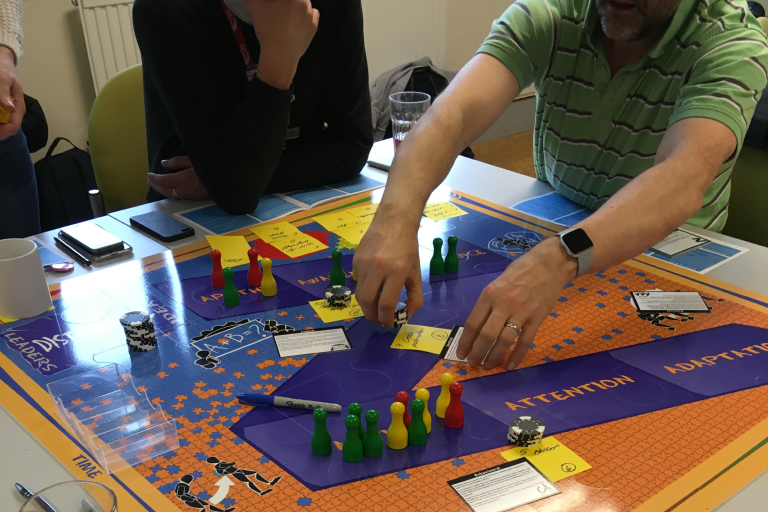What is Colltrain?
A case for excellent training delivered online using experiential learning
A few days ago, I got a happy client asking me how she could answer some questions that other people frequently ask when she wholeheartedly recommends Colltrain as the best tool for remote training delivery.
I’ve imagined the answer to this question as a classical board game of “Ask and Tell”.
Trainer, flip off the cards… 3, 2, 1, Go!

Marian Stirbescu – Colltrain Product Managers
What is Colltrain?
COLLaborative TRAINing software empowers trainers and facilitators to succeed with remote delivery. Got it? COLL + TRAIN = Colltrain. No fuss, no buzz.
The Colltrain app is available as a service at colltrain.com.
Is it costly or…?
I am pleased to bear good news! Not at all.
As a trainer or facilitator, you can use Colltrain for free, with groups of a maximum of 6 participants and work with large groups (up to 99 per event) with a paid plan that amounts to a monthly cost which is less than what it costs to prepare the printed material for a single in-class session.
But how does it work?
With online training, you would probably use break-out rooms. Before splitting the group, you will start the activity in Colltrain (as a facilitator).
Once the teams join their rooms on the conferencing platform (Zoom, MS Teams, and Google Meet included), you will join each room and pass the dedicated link to each team.
The participant teams will carry on the activity following the given instructions. Please note that they play collaboratively on the same flipchart, board game, etc., using their computer, a compatible browser and a mouse (optional).
Once the activity is completed, you may start the debriefing and help the participants to achieve a great understanding of the course topics while enjoying a high level of engagement.
DONE!
But why do we need that?
Let’s step back a little bit and build a more detailed picture. Usually, a training business gets three categories of stakeholders strongly invested in its success.
The usual suspects are participants (delegates), trainers and sponsors or supporters of the learning initiative.
From the participant’s points of view
- Participants miss the enjoyment of traditional training
- Some of them may be feeling not engaged and sceptical
- Low value, mediocre experience
- It’s boring to offer attention to a “talking head.”
From the trainer’s point of view
They accept that online delivery may lack the quality they usually offer when delivering in-class sessions.
Trainers may feel at a disadvantage as they don’t yet possess the knowledge and the tools to replicate the in-class experience online.
The general public perspective
The general public (management, sponsors of learning initiatives, and clients in general) can see that the pandemic has accelerated the adoption of remote training (5+ years) by many organisations.
Nowadays, as those restrictions are gone, organisations across the world can see that this form of delivery with a trainer interacting synchronously with a group over Zoom has its advantages:
- Better budget spending. Just cut off the travel and accommodation costs, and you have freed additional financial resources to develop even more employees.
- Greater flexibility in organising training groups using a schedule of 4 to 8 hours
- With the right tools and knowledge, you can achieve a learning experience similar to the in-class one or, in some cases, even a better one.
As a consequence, they expect trainers to be able to deliver the same learning program both in-class and online, following a reasonably similar schedule of training activities and aiming at similar results.
Is this an advantage for me as a trainer/facilitator?
That is what many of our active users (trainers and facilitators) experience nowadays.
Today you deliver an in-class session in Greater London, and tomorrow you may provide the same title to a team of participants from across Europe: Paris, Barcelona, Berlin, Budapest, Amsterdam and Bucharest.
Isn’t that brilliant?
We give a hand by offering trainers a library of free training activities so they can jump-start their training sessions. Facilitators could draw inspiration from the Colltrain library and create new activity designs.
So does it look like it’s the new normal?
Yes, we believe it is. Brace yourself for even more pleasant surprises as the percentage of online vs in-class delivery will slowly but surely grow.
Why a new app?
First, I would ask you a question: Are Zoom and MS teams apps enough to offer a complete learning experience? Many trainers could answer in unison … well no, not at all.
There are a lot of apps out there that focus on working jointly on a file or board. The majority of them serve well in various use cases like:
- Documenting
- Facilitating Agile events
- As a visual aid for meetings and workshop
As a trainer, you understand right away that with these tools, it is almost impossible to transform your in-class activities to the detail and workflow you look to achieve.
Infinite boards keep participants in a continuous state of confusion; the effort to duplicate files to mimic rooms puts a lot of pressure on trainers and inhibits flexibility and creativity.
Colltrain is filling this gap in the market by offering a dedicated platform for online synchronous training.
What’s your job in this new market?
At Colltrain, we are delighted to empower people worldwide to get a beautiful learning experience with remote training.
We frame ourselves as an EdTech Start-up.
We’ve embraced our mission to create the tools required for transforming experiential training activities into online activities second to none.
Currently, we support more than 250 learning and development professionals, mainly from Europe, to fulfil their role as online trainers.
They are the creators of a new way of delivering great learning to participants but with a global ambition.
Marian
Co-founder of Colltrain.







